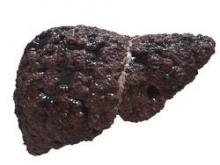Hospital mortality among patients with cirrhosis fell by 41% in the United States between 2002 and 2010, far outpacing improvements in survival among inpatients who did not have cirrhosis, researchers reported in the May issue of Gastroenterology (2015 [doi:10.1053/j.gastro.2015.01.032]).
The drop occurred even though cirrhosis inpatients were older and had more comorbidities by the end, compared with the beginning of the study, said Monica Schmidtat the University of North Carolina Liver Center and the Gillings School of Global Public Health in Chapel Hill, N.C., and her associates. The finding was “remarkably consistent across several cirrhosis complications, and [suggested] improving cirrhosis care that may extend beyond general improvements in inpatient care,” the researchers added. “On the other hand, sepsis had an increasing mortality risk, suggesting that cirrhotic patients may need a more tailored approach to sepsis,” they said.
Source: American Gastroenterological Association
New treatments have emerged in the past 10-15 years for several complications of cirrhosis, including hepatorenal syndrome, variceal bleeding, spontaneous bacterial peritonitis, ascites, and hepatocellular carcinoma, Ms. Schmidt and her associates noted. To study the extent to which these advances and updated guidelines have entered hospital practice, they examined 781,515 hospitalizations with a diagnosis of cirrhosis, and equal numbers of hospitalizations without cirrhosis or with congestive heart failure. Data were from the National Inpatient Sample of the Healthcare Cost and Utilization Project, which includes 46 states and is the single largest all-payer inpatient database in the country. Cohorts were matched by age, sex, and year of hospital discharge from 2002 through 2010.
Hospital mortality among cirrhosis patients dropped by 41% (from 9.1% to 5.4%) during the 8 years of the study, compared with declines of 44% for inpatients with congestive heart failure and 19% for inpatients without cirrhosis, the investigators said. Furthermore, the independent risk of dying in the hospital among cirrhosis patients declined steadily to 0.50 by the end of the study (95% confidence interval, 0.48-0.52), despite the population’s increasing age and medical complexity. Hospital mortality rates were higher for subgroups of cirrhosis patients with hepatorenal syndrome, hepatocellular carcinoma, variceal bleeding, and spontaneous bacterial peritonitis, but independent mortality risks for each of these conditions fell progressively over time, the investigators noted.
In contrast, cirrhosis inpatients with sepsis were 22% more likely to die in the hospital in 2010 than in 2002 (relative risk in 2002, 3.6; 95% CI, 3.3-3.95; RR in 2010, 4.6; 95% CI, 4.4-4.8), the researchers found. The increase was so marked that the mortality risk related to sepsis in 2010 exceeded even that for hepatorenal syndrome, they said. The unexpected finding contradicted a report of declining overall sepsis-related mortality, which was based on the same data source and a similar time period, the investigators noted.
“Cirrhosis patients have particularly poor hemodynamic reserve, with wider perturbations in immune inflammatory and compensatory responses that could hinder survival,” they commented. “Therefore, it is possible that cirrhosis patients are doing much worse with sepsis, compared with other patients. The surviving sepsis campaign may need guidelines that specifically target cirrhosis patients.”
The National Institutes of Health partly funded the study. The authors reported having no relevant conflicts of interest.


